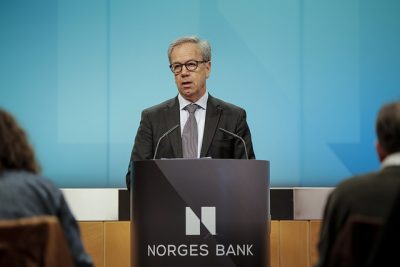The executive board of Norway’s central bank cautiously raised interest rates on Thursday for the first time in seven-and-a-half years, but not as much as predicted. An increase was widely expected and even viewed as good news because it’s a sign of renewed strength in the Norwegian economy, while some economists question whether the rise was necessary.

The bank board decided to raise the central bank’s key policy rate by just a quarter-point, from 0.5 percent to 0.75 percent. That shouldn’t have any dramatic effect on Norwegians’ ability to meet mortgage payments, and the board at Norges Bank itself cited how the increase reflects an “upturn” in the Norwegian economy that’s continuing.
The board clearly feels that the economy, which is recovering from a collapse in oil prices in 2014, can tolerate an interest rate rise after years of unusually low rates. The key policy rate had been sitting at its historically low level of 0.5 percent since March of 2016.
The interest rate rise did not immediately strengthen the value of the Norwegian krone, however. It had been gaining strength this week in the run-up to the bank board’s announcement, and was trading at just over NOK 8.10 to the US dollar Thursday morning. Within an hour of the announcement, however, it cost NOK 8.23 to buy a dollar, signalling that the krone actually fell against the dollar once again. Analysts suggested it will take some time for the slight increase in interest rates to have an effect on the country’s currency.
More rate rises likely
The interest rate hike is now expected to be followed by a series of as many as six cautious increases over the next three years. “Overall, the outlook and the balance of risks imply a gradual interest rate rise in the years ahead,” the board confirmed in its press release on Thursday. It argued that if the key policy rate had remained at its historically low level “for too long,” price and wage inflation could accelerate and “financial imbalances” could build up further.
Øystein Olsen, governor of Norges Bank, also sent out a signal about when another interest rate rise may be announced: “The Executive Board’s current assessment of the outlook and balance of risks suggest that the key policy rate will most likely be increased further in the first quarter of 2019,” Olsen stated. That also suggests the key policy rate against which other interest rates are pegged will stay at 0.75 through the rest of the year.
Bracing for higher rates
Newspaper Dagens Næringsliv (DN), Norway’s major financial daily, had already editorialized on Monday that a rate hike would be a good thing: “It means that the Norwegian economy is growing and that employment is picking up again.” DN noted that borrowers who have taken on large mortgages during the recent real estate boom will hardly cheer the rate rise, though. An ongoing rise in interest rates “can be tough for those who have stretched to get into the housing market,” DN wrote, even though banks have stricter lending requirements and lenders need to meet various “stress tests.”
Finance Minister Siv Jensen stated last week that she personally manages her own finances with an eye to interest rates as high as 10 percent. She doesn’t think that will happen, but she, like many others remembers how high interest rates can get. Mortgage rates were as high as 18 percent in the late 1980s and remained in the double digits for years. The recent period of record low interest rates has been the exception, not the rule, in the post-war period.
Rising interest rates are also good news for those with money in the bank who haven’t enjoyed any returns of substance in recent years. DN reported that Norwegians, not known as big savers, nonetheless have around NOK 1,000 billion stashed in bank accounts that have been earning next to nothing. Now the money stands to generate some earnings.
‘Unnecessary’
Despite the generally positive reception to Thursday’s interest rate rise, four out of five economists and analysts interviewed by DN this week felt it was unnecessary. Kari Due-Andresen, chief economist at Handelsbanken Capital Markets, for example, said she didn’t think the Norwegian economy needed an interest rate rise right now. She argued that the hot housing market has already cooled off and that she’d like to see more economic growth, higher employment levels and inflation before an interest rate rise clicks in.
She was joined by Professor Ragnar Torvik at NTNU, who thought the central bank could wait with an interest rate hike, agreeing that “there’s a need for low rates to increase employment further.” Professor Steinar Holden at the University of Oslo agreed, as did Knut Røed, a senior researcher at Frischsenteret. Røed claimed that Norway’s high levels of household debt and municipal debt will have a restrictive effect on the economy. The economic upturn is “a bit too fragile,” he said, for such restrictions now.
Only Hilde C Bjørnland, a professor at the Norwegian Business School BI, thinks the bank board was correct in sending a “clear signal” that rates will start rising. Unemployement has fallen and growth is rising, meaning that Norway’s economy should be stimulated to a lesser degree by low interest rates.
Due-Andresen noted, meanwhile, that Norway’s central bank would have faced a major communications problem if it had not raised rates on Thursday. Olsen has hinted about a rate rise this fall for so long that the bank risked losing credibility if its board didn’t follow through. Its next interest rate meeting is scheduled in late October.
newsinenglish.no/Nina Berglund

